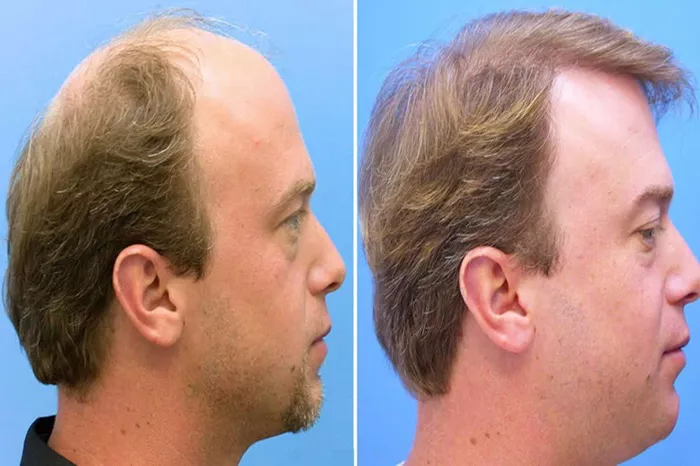Hair transplant procedures have come a long way in providing natural-looking results to individuals experiencing hair loss. Here’s what you need to know about the natural appearance of transplanted hair.
Understanding Hair Transplantation
Hair transplantation is a surgical procedure aimed at restoring hair growth in areas affected by baldness or hair thinning. It typically involves transferring hair follicles from a donor area (usually the back or sides of the head) to the recipient site (balding or thinning areas). The success of hair transplantation largely depends on the technique used and the skill of the surgeon.
SEE ALSO: Can Hair Transplant Be Done Twice?
Techniques for Natural Results
Follicular Unit Transplantation (FUT):
In FUT, a strip of skin with hair follicles is harvested from the donor area. The follicular units (natural groups of one to four hairs) are then carefully dissected and transplanted into the recipient sites. This method ensures that the transplanted hair mimics the natural growth pattern and direction.
Follicular Unit Extraction (FUE):
FUE involves harvesting individual follicular units directly from the donor area using tiny punches. These units are then transplanted into the recipient sites. FUE is known for its minimally invasive nature and ability to achieve natural-looking results without leaving a linear scar.
Factors Influencing Natural Appearance
Achieving natural-looking results from a hair transplant depends on several factors:
Hairline Design:
The hairline design is crucial in determining the overall aesthetic outcome. A skilled surgeon takes into account factors such as age, facial structure, and existing hair pattern to create a natural-looking hairline.
Graft Placement:
The angle, orientation, and density of graft placement play a significant role in how natural the transplanted hair appears. Proper placement ensures that the hair blends seamlessly with the existing hair.
Donor Hair Quality:
The quality of donor hair, including its texture, color, and caliber, affects the final result. Good quality donor hair closely matches the recipient’s natural hair characteristics.
Recovery and Growth Phases
After a hair transplant, the transplanted hair goes through several phases:
Initial Shedding:
Within the first few weeks, the transplanted hair sheds as part of the normal hair growth cycle.
Growth Phase:
New hair growth typically begins around 3-4 months post-procedure. The hair continues to thicken and mature over the following months.
Final Result:
The final result of a hair transplant is usually evident around 12-18 months after the procedure. By this time, the transplanted hair blends seamlessly with the existing hair, providing a natural appearance.
Maintenance and Long-Term Results
To maintain natural-looking results after a hair transplant, it’s essential to follow post-operative care instructions provided by your surgeon. This may include:
Medication:
Use of prescribed medications to support hair growth and prevent further hair loss.
Hair Care:
Gentle handling of the transplanted hair during washing and styling to avoid damage.
Regular Follow-ups:
Scheduled follow-up visits with your surgeon to monitor progress and address any concerns.
Conclusion
In conclusion, modern hair transplantation techniques such as FUT and FUE can provide natural-looking results when performed by a skilled and experienced surgeon. Factors such as hairline design, graft placement, and the quality of donor hair significantly influence the final outcome. With proper care and attention during the recovery phase, individuals can enjoy restored hair that blends seamlessly with their natural hair, enhancing overall appearance and confidence.
Understanding the nuances of hair transplantation and choosing a qualified surgeon are key steps towards achieving the natural-looking hair restoration you desire.
FAQs
Why Doesn’t Transplanted Hair Look Natural?
Transplanted hair may not always look natural due to several reasons:
Improper Hairline Design: Poorly designed hairlines can appear unnatural. A hairline that is too straight or placed incorrectly in relation to facial features can be a giveaway.
Unnatural Density: Overly dense placement of grafts in the recipient area can result in a “pluggy” appearance, where the transplanted hair stands out noticeably from the surrounding hair.
Mismatched Hair Characteristics: If the donor hair used does not match the recipient’s natural hair in terms of texture, color, or curl pattern, it can appear unnatural.
Complications and Poor Surgical Technique: Complications during surgery or poor technique can lead to uneven growth, scarring, or damage to existing hair, affecting the natural appearance.
Does Anyone Regret Hair Transplant?
While hair transplants generally yield positive outcomes, some individuals may regret their decision due to:
Unrealistic Expectations: Expecting dramatic changes in appearance or perfect results may lead to disappointment if expectations are not met.
Complications: Like any surgical procedure, hair transplants carry risks such as infection, scarring, or poor aesthetic outcomes, which can lead to regret.
Financial Considerations: The cost of hair transplant surgery can be significant, and individuals may regret the expense if they are dissatisfied with the results.
Did People Notice Your Hair Transplant?
Whether people notice a hair transplant depends on various factors:
Skill of the Surgeon: A skilled surgeon can create a natural-looking result that blends seamlessly with existing hair, making the transplant less noticeable.
Hairline Design: A well-designed hairline that matches natural hair growth patterns and facial features reduces the likelihood of others noticing the transplant.
Timing: Transplanted hair goes through shedding and growth phases. Initially, there may be a noticeable change, but as the hair grows and matures, it becomes less conspicuous.
Confidence and Styling: How confident the individual feels about their new hair and how well they style it can influence whether others notice the transplant.
You May Be Interested In

